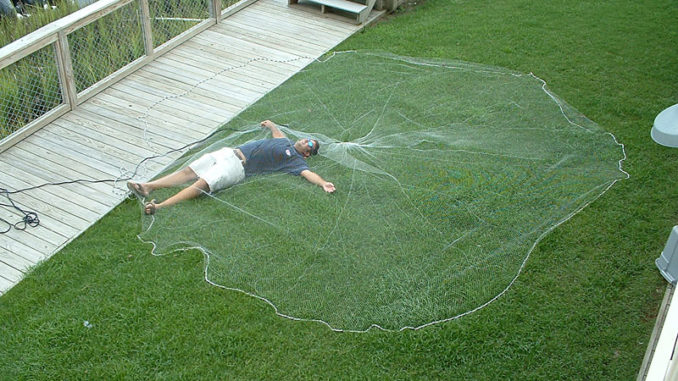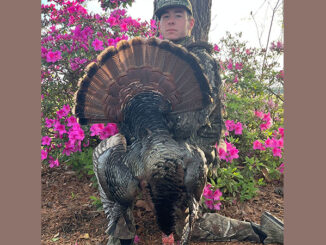
King mackerel fishing in the fall
Okay, sometimes you can catch king mackerel on dead bait nearly as well as you can on live. But the fall in the Carolinas is most definitely not that time. When the kings hit the beaches in October, they are coming to gorge on the waves of big menhaden present at the same time.
Mullet and bluefish are often present as well, but it’s usually the big pogies that get the job done in October. Forget the skirts, or anything fancy. A single, naked pogie on two treble hooks is the most deadly-effective fall king mackerel bait of all time. Literally every citation king mackerel I have caught while targeting them has come on a big, single, naked bait.
Menhaden in the fall can be a great deal trickier to net than late spring or summer bait. The smaller bait common in the warmest months tends to run right up onto the beach and hang around. But fall bait tends to move. Filling your livewells in October can often be difficult. So anglers must find ways to compensate for the greater difficulty.
First, you need the correct cast net for the season. You need a minimum of a 10-foot net in October, and 12-foot is preferable. Perhaps even more importantly, you need enough weight on the net (the aggregate weight of the lead on the lead line) to get the net to go down when it hits the water.
Find the proper weight
Tackle companies often push and sell too many nets that are just too light for big, active fall baits. For example, the 10-foot Betts Super Pro is weighted at just 14 pounds. If you must throw that net at a school of bait in 30 feet of water, your haul is probably going to be a bit lighter than you would prefer. On the charter boat, we ultimately went to a custom 10-foot net that weighed in at more than 18 pounds on the lead line. The additional 4 pounds made a huge difference in deep water.
The mono on the net also makes a difference. We experimented for a while with nets constructed of a thinner mono. The net definitely got down quicker, but some durability issues quickly became apparent.
Obviously thicker mono is going to be more durable. But the thicker gauge slows the rate of sink. The size of the gaps in the net are vital. In the fall, nothing smaller than 5/8-inch mesh will do the job. The bigger the gap, the quicker the sink. Once again, you have to get the net down.
Throwing a net at fall bait requires good boat positioning from the captain to intercept the school while drifting as much as possible. And it forces the actual net thrower to use some good techniques.
Spin and throw
Everyone has their own twist on how to load and throw a net, but they all have one constant. Just like swinging a golf club, you must maintain acceleration through the process of throwing, right up until you release the net from your hands. You can only get poor to moderate results if the technique isn’t there.
The late, great, Capt. Roger Gales used to spin with the net in a complete circle, using his feet and body rather than just his arms to accelerate and launch. If he wanted to throw at a spot that was at 11 o’clock relative to the bow of the boat, he started by pointing directly at 11 o’clock, with the net already coiled and loaded.
Being left-handed, Capt. Roger started to turn his body toward his left shoulder, going counterclockwise, and slowly speeding up the same way. The last third of the circle was where he ramped up to full effort, and he began the release of the net when he was pointed somewhere between 11:30 and 12 o’clock.
When he reached the 11 o’clock point where he had started, only the loop to retrieve the net was left in his hands. Once I figured out that (being a righty) I had to load the net and spin the exact opposite way that Capt. Roger did, I found out that it took very little effort to fling and open my net.
Practice on land
My results got markedly better in terms of how much bait I brought to the boat. Even if I had to throw the net a bunch of times, I was a lot less sore than before, where my technique was a lot more violent and often made me visit the chiropractor on non-fishing days.
With whatever net and whichever technique you eventually land on, it’s always a good idea to practice on dry land before you get the net wet. Play around with it a bit and find what works for you best. Don’t be afraid to change things up and just see if a tweak here and there can improve your cast net game.
You don’t have to throw the net a certain way just because your buddy does. Just make sure your lead line is free of tangles and that you’re accelerating the whole way through the throw. Pretty soon, you’ll be competent enough that you’ll have to throw at the side of the bait balls, rather than the center, so you don’t catch too many fall menhaden. You only need what you’re going to fish with, and then maybe a few more for some fresh chum. In terms of bait, it’s all you really need for catching some smoker kings.
Cast net techniques:
Many techniques allow anglers to make fully open and accurate cast net throws. Some look awkward during the process, but have great results. Experiment with different ideas until you find what works best for you while putting as little strain on your body as possible.




Be the first to comment